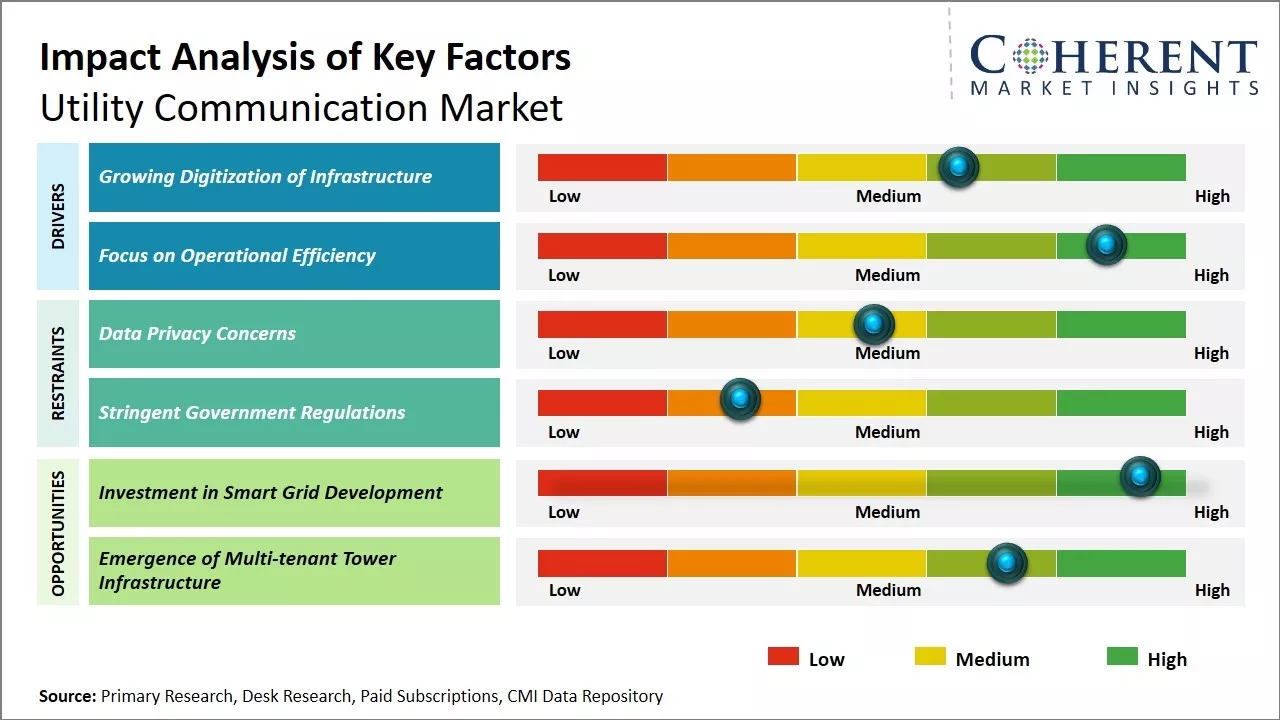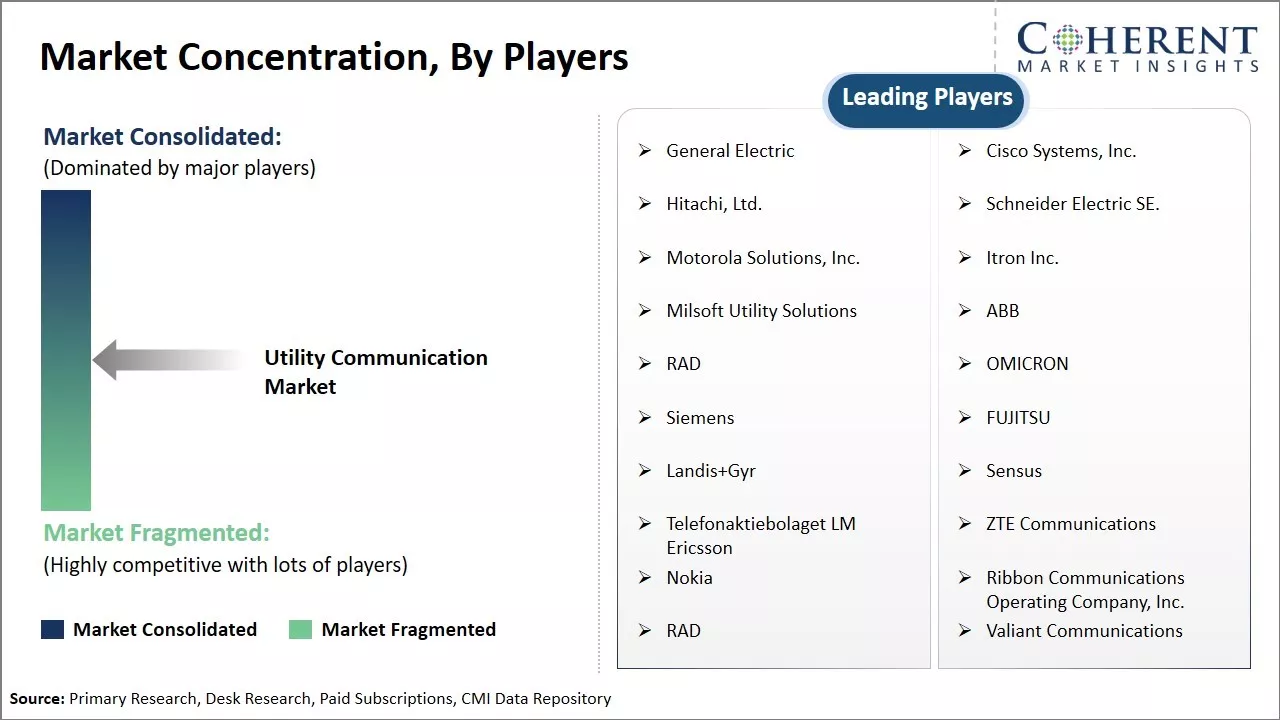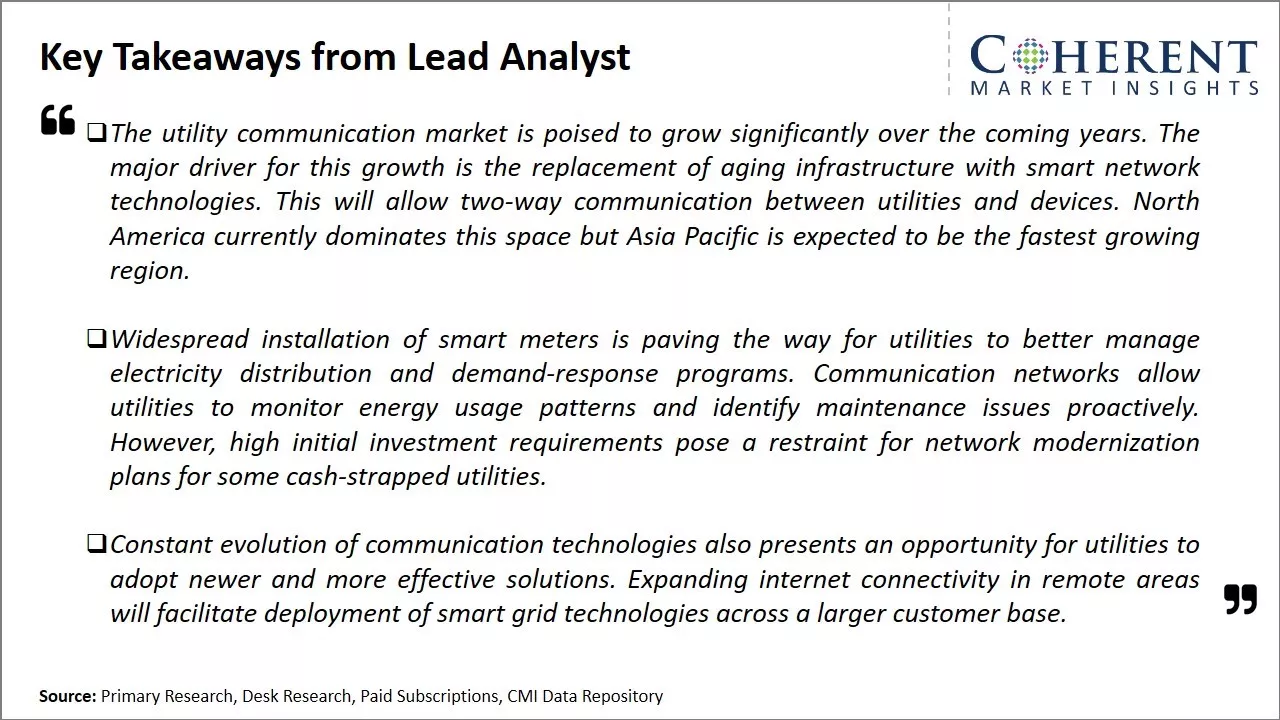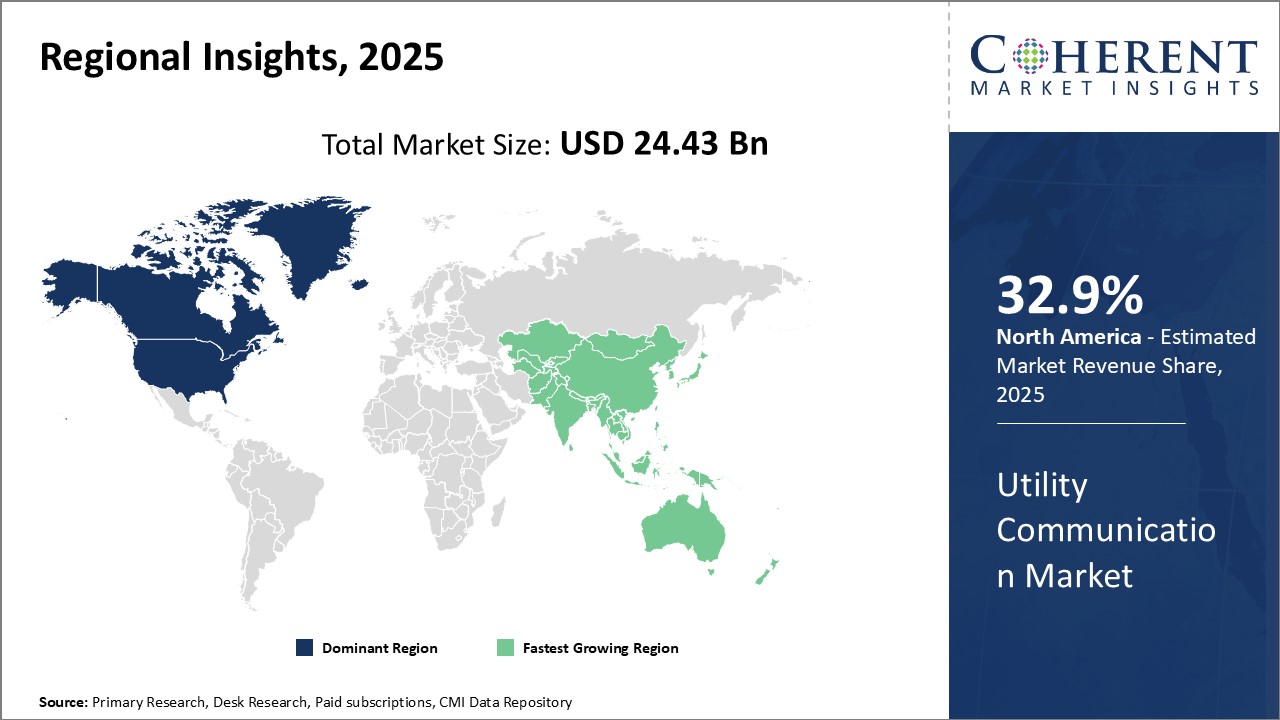Utility Communication Market Size and Trends
The utility communication market is estimated to be valued at USD 24.43 Bn in 2025 and is expected to reach USD 36.28 Bn by 2032, growing at a compound annual growth rate (CAGR) of 5.8% from 2025 to 2032.

Discover market dynamics shaping the industry: Download Free Sample
The utility communication market is expected to witness significant growth during the forecast period. The growth of this market is attributed to factors such as the growing demand for smart grid networks, adoption of Internet of Things (IoT) solutions for asset monitoring in utilities, increasing investments towards upgrading aging power infrastructure, and rising focus on integrating renewable energy into the existing grid. Various government initiatives to modernize the aging utility infrastructure also supports the demand for advanced communication networks. Emerging technologies such as private LTE/5G networks and distributed energy resources management systems are creating new opportunities for communication service providers operating in this market.
Growing Digitization of Infrastructure
The digitization of infrastructure and services has emerged as an inevitable trend across utility industries in recent years. Traditional energy, water, and transportation grids are progressively incorporating advanced digital technologies and internet-of-things solutions to improve operational efficiency, enable predictive maintenance, enhance customer services, and support sustainability goals. Two-way communication networks laying the foundation for smart grid applications have become essential for utilities to leverage real-time data insights. This allows the remote monitoring of assets, automated detection of faults and outages, as well as offering flexibility in demand response management. 5G cellular rollout is further making connectivity ubiquitous by ensuring high data speeds and low latency even in remote areas. Utilities are able to better optimize resource allocation, boost system resilience, and respond proactively to disruptions with enhanced communication infrastructure. Going digital also improves customer experience through personalized services, from online billing to demand forecasting tools. The digitalization drive ultimately helps organizations transition to a more decentralized, Cleanweb future with two-way power flow, localized storage, and distributed energy resources playing a much larger role. Robust utility communication networks therefore constitute a vital backbone supporting modernization initiatives across the sector.
For instance, in 2020, NetCom BW, one of the largest suppliers of energy in Germany and Europe, embarked on a project to upgrade the existing network to the IP standard, in support of EnBW’s mission to diversify operations and provide new customer-centric solutions.
Market Concentration and Competitive Landscape

Get actionable strategies to beat competition: Download Free Sample
Focus on Operational EfficiencyIn the current economic climate defined by rising costs of materials and labor, improving operational efficiency has become a top priority for utility companies. Aging infrastructure, increasing demand coupled with budget constraints pose challenges for reliable and sustainable service delivery. Advanced communication solutions enable remote asset control and performance monitoring which allows utilities to reduce manpower requirements for routine operations and maintenance tasks. Data collected from smart grids and sensors installed across the network can be analyzed using AI algorithms to detect anomalies, predict equipment failures, and optimize dispatch scheduling. This helps minimize unplanned downtime, avoid catastrophic damage to assets and cut spend on repairs. 5G connectivity with its high bandwidth further supports real-time video feed applications for inspection of transmission lines and pipelines from control centers. Reliable communication is key to condition-based and predictive maintenance strategies that maximize uptime and throughput of generation and distribution facilities. Utilities are leveraging latest technologies to streamline operations, enhance grid visibility and resilience as well as lower total cost of ownership through automation and technology integration. Ubiquitous connectivity acts as the backbone supporting such efficiency enhancing initiatives.
For instance, Hitachi Energy Ltd., energy solutions provider company, offers utility-grade communication solution FOX615 that provides a long product lifecycle, lower maintenance costs, and guaranteed performance in harsh environments and across a broad range of temperatures.

To learn more about this report, Download Free Sample
Market Challenges: Data Privacy ConcernsThe utility communication market faces several challenges. One major challenge is the aging infrastructure that needs upgrades to support new technologies. Utilities also struggle with cybersecurity issues as the grid becomes more connected. Convincing customers to adopt smart meters and other connected devices can be difficult. Regulatory hurdles and uncertainty surrounding data privacy laws also hampers growth and innovation. Maintaining reliable service during extreme weather or other disruptions while transitioning to renewable energy sources adds further complexity.
Market Opportunities: Investment in Smart Grid Development
The push for modernization and smart grid development opens opportunities for network upgrades. Connected devices will drive new revenue streams from data services and customer analytics. Utilities can improve efficiency, reduce costs and better manage supply and demand by leveraging real-time network data. Adopting cost-effective wireless solutions makes extending connectivity easier.

Discover high revenue pocket segments and roadmap to it: Download Free Sample
Insights, by Technology - Infrastructure Development Drives Wired Utility Communications AdoptionThe wired segment is estimated to contribute the highest share of 64.9% in 2025 in the market owing to the ongoing development of the utility infrastructure across regions. Wired solutions offer reliable, high-speed connectivity essential for utility operations and expanding consumer access. Governments prioritize wired network upgrades to power grids and other critical systems. This ensures network resilience during extreme events. Utilities also rely on wired networks to monitor remote assets, enabling preventive maintenance.
Wired networks experience growing deployment as smart city initiatives require connected infrastructure. The integration of wired technologies supports real-time data exchange between utilities and various city management systems. Reliable wired connectivity further allows distributors to offer advanced metering services. Two-way communication through wired networks helps improve demand response and power quality.
Ongoing fiberization of core networks augments utility connectivity. Fiber lays the foundation for utilities to harness big data capabilities and deploy advanced analytics. This allows for predictive maintenance and improving resource efficiency. High-bandwidth options such as Fiber-To-The-Home also expand utilities' reach in servicing consumers directly.
Insights, by Utility Type - Public Utilities Lead Wireless Adoption for Service Continuity
The public segment is estimated to contribute the highest share of 74.8% in 2025 in the market as wireless solutions ensure service reliability. Public utilities serve broader populations and geographical areas compared to private utilities. Wireless networks enable cost-effective connectivity across vast territorial grids maintained by public distributors.
Rural electrification programs rely on wireless networks for last-mile connectivity in remote regions lacking wired infrastructure. This expands energy access for underserved communities. Public utilities also deploy wireless solutions for monitoring substations across locations difficult to reach via wired networks. This maintains operational visibility regardless of terrain challenges.
Moreover, wireless networks support quick restoration efforts after natural disasters disrupt wired infrastructure. Public utilities prioritize fast recovery of services. Wireless technologies provide flexibility to rapidly install temporary networks until wired systems can be repaired. Reliance on wireless solutions thus helps public utilities uphold their social responsibility of guaranteeing uninterrupted supply.
Insights, by Application - Power Generation Automation Increases Wireless Adoption
Power generation is estimated to contribute the highest share of 52.7% in 2025 in the market as facilities upgrade legacy systems. Wireless solutions enable cost-effective modernization across generation plants. Power generators rely on wireless connectivity to automate plant operations remotely. Wireless networks facilitate condition-based maintenance at generator assets spread over large footprints.
Sensors deployed on turbines, boilers and other equipment stream diagnostic data via wireless networks. This drives predictive maintenance programs for improving plant efficiency. Wireless solutions also support supervisory control and data acquisition for unmanned plants. Operators can oversee generation from central control rooms through wireless connectivity.
Renewable energy integration increases wireless usage at power sites. Monitoring of wind turbines and solar panels relies on wireless networks owing to the distributed nature of renewable assets. Wireless connectivity optimizes renewable energy production based on real-time asset performance data. It also helps coordinate power dispatch from renewables based on shifting grid demands. Overall, wireless networks play a growing role in enabling digital transformation across the generation sector.
Regional Insights

Need a Different Region or Segment? Download Free Sample
North America has established itself as the dominant region in the utility communication market. The region is estimated to hold the market share of 32.9% in 2025. The region is home to some of the largest utility companies globally with well-developed transmission and distribution infrastructure. With decades of experience, North American utilities have embraced new technologies much earlier than other parts of the world to modernize their operations. They have invested heavily in smart grid technologies, advanced metering solutions, distribution automation systems and communication networks to improve network visibility, efficiency and reliability. Driven by the need to upgrade aging infrastructure, meet stringent reliability standards and deliver enhanced customer experiences, communication spending in the utility sector has increased substantially over the last few years. Various field area networks, wireless technologies, internet of things solutions and cloud-based applications have been widely adopted across the region.
The Asia Pacific region has emerged as the fastest growing market for utility communication globally. Rapid urbanization, expansion of transmission and distribution networks, government initiatives towards smart grid rollouts and the influx of new technologies have propelled growth. Countries like China and India with their large populations and burgeoning energy demands have become hotspots. Chinese utility firms, both state-owned and private, have allocated billions towards smart infrastructure to modernize their grid systems and meet renewable energy targets. In India as well, a major focus on rural electrification and strengthening transmission infrastructure has opened up opportunities for communication providers. Additionally, other Southeast Asian countries have also witnessed a surge in investments towards strengthening utility automation and monitoring capabilities. The imminent need as well as affordability of newer solutions makes the Asia Pacific region an attractive and lucrative market for technology vendors and solution providers alike.
Market Report Scope
Utility Communication Market Report Coverage
| Report Coverage | Details | ||
|---|---|---|---|
| Base Year: | 2024 | Market Size in 2025: | USD 24.43 Bn |
| Historical Data for: | 2020 To 2024 | Forecast Period: | 2025 To 2032 |
| Forecast Period 2025 to 2032 CAGR: | 5.8% | 2032 Value Projection: | USD 36.28 Bn |
| Geographies covered: |
|
||
| Segments covered: |
|
||
| Companies covered: |
Solutions, ABB, RAD, OMICRON, Siemens, FUJITSU , Landis+Gyr, Sensus, Telefonaktiebolaget LM Ericsson, ZTE Communications, Nokia, Ribbon Communications Operating Company, Inc., RAD, and Valiant Communications |
||
| Growth Drivers: |
|
||
| Restraints & Challenges: |
|
||
Uncover macros and micros vetted on 75+ parameters: Get instant access to report
Market Segmentation
- Technology Insights (Revenue, USD BN, 2020 - 2032)
- Wired
- Wireless
- Component Insights (Revenue, USD BN, 2020 - 2032)
- Software
- Hardware
- Services
- Utility Type Insights (Revenue, USD BN, 2020 - 2032)
- Public
- Private
- Application Insights (Revenue, USD BN, 2020 - 2032)
- Oil and Gas
- Power Generation
- Others
- Regional Insights (Revenue, USD BN, 2020 - 2032)
- North America
- U.S.
- Canada
- Latin America
- Brazil
- Argentina
- Mexico
- Rest of Latin America
- Europe
- Germany
- U.K.
- Spain
- France
- Italy
- Russia
- Rest of Europe
- Asia Pacific
- China
- India
- Japan
- Australia
- South Korea
- ASEAN
- Rest of Asia Pacific
- Middle East & Africa
- GCC Countries
- Israel
- Rest of Middle East & Africa
- North America
- Key Players Insights
- General Electric
- Cisco Systems, Inc.
- Hitachi, Ltd.
- Schneider Electric SE.
- Motorola Solutions, Inc.
- Itron Inc.
- Milsoft Utility Solutions
- ABB
- RAD
- OMICRON
- Siemens
- FUJITSU
- Landis+Gyr
- Sensus
- Telefonaktiebolaget LM Ericsson
- ZTE Communications
- Nokia
- Ribbon Communications Operating Company, Inc.
- RAD
- Valiant Communications
Share
Share
About Author
Monica Shevgan has 9+ years of experience in market research and business consulting driving client-centric product delivery of the Information and Communication Technology (ICT) team, enhancing client experiences, and shaping business strategy for optimal outcomes. Passionate about client success.
Missing comfort of reading report in your local language? Find your preferred language :
Transform your Strategy with Exclusive Trending Reports :
Frequently Asked Questions
EXISTING CLIENTELE
Joining thousands of companies around the world committed to making the Excellent Business Solutions.
View All Our Clients
